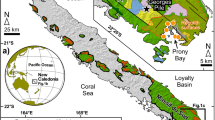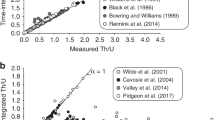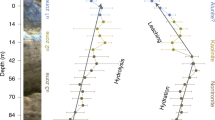Abstract
Images of geomorphological features that seem to have been produced by the action of liquid water have been considered evidence for wet surface conditions on early Mars1. Moreover, the recent identification of large deposits of phyllosilicates, associated with the ancient Noachian terrains2,3 suggests long-timescale weathering4 of the primary basaltic crust by liquid water2,5. It has been proposed that a greenhouse effect resulting from a carbon-dioxide-rich atmosphere sustained the temperate climate required to maintain liquid water on the martian surface during the Noachian6,7. The apparent absence of carbonates and the low escape rates of carbon dioxide8, however, are indicative of an early martian atmosphere with low levels of carbon dioxide. Here we investigate the geochemical conditions prevailing on the surface of Mars during the Noachian period using calculations of the aqueous equilibria of phyllosilicates. Our results show that Fe3+-rich phyllosilicates probably precipitated under weakly acidic to alkaline pH, an environment different from that of the following period, which was dominated by strongly acid weathering9 that led to the sulphate deposits identified on Mars10,11,12. Thermodynamic calculations demonstrate that the oxidation state of the martian surface was already high, supporting early escape of hydrogen. Finally, equilibrium with carbonates implies that phyllosilicate precipitation occurs preferentially at a very low partial pressure of carbon dioxide. We suggest that the possible absence of Noachian carbonates more probably resulted from low levels of atmospheric carbon dioxide, rather than primary acidic conditions13. Other greenhouse gases may therefore have played a part in sustaining a warm and wet climate on the early Mars.
This is a preview of subscription content, access via your institution
Access options
Subscribe to this journal
Receive 51 print issues and online access
$199.00 per year
only $3.90 per issue
Buy this article
- Purchase on Springer Link
- Instant access to full article PDF
Prices may be subject to local taxes which are calculated during checkout




Similar content being viewed by others
References
Malin, M. C. & Edgett, K. S. Evidence for persistent flow and aqueous sedimentation on early Mars. Science 302, 1931–1934 (2003)
Poulet, F. et al. Phyllosilicates on Mars and implications for the early Mars history. Nature 481, 623–627 (2005)
Bibring, J.-P. et al. Mars surface diversity as revealed by the OMEGA/Mars Express observations. Science 307, 1576–1581 (2005)
Meunier, A. & El Albani, A. The glauconite–Fe-illite–Fe-smectite problem: a critical review. Terra Nova 19, 95–104 (2006)
Bibring, J. P. et al. Global mineralogical and aqueous Mars history derived from OMEGA/Mars express data. Science 312, 400–404 (2006)
Jakosky, B. M. & Phillips, R. J. Mars’ volatile and climate history. Nature 412, 237–244 (2001)
Pollack, J. B., Kasting, J. F., Richardson, S. M. & Poliakoff, K. The case for a wet, warm climate on early Mars. Icarus 71, 203–224 (1987)
Barabash, S., Fedorov, A., Lundin, R. & Sauvaud, J. A. Martian atmospheric erosion rates. Science 315, 501–503 (2007)
Tosca, N. J. et al. Geochemical modeling of evaporation processes on Mars: insight from the sedimentary record at Meridiani Planum. Earth Planet. Sci. Lett. 240, 122–148 (2005)
Arvidson, R. E. et al. Spectral reflectance and morphologic correlations in Eastern Terra Meridiani, Mars. Science 307, 1591–1594 (2005)
Gendrin, A. et al. Sulfates in Martian layered terrains: the OMEGA/Mars Express view. Science 307, 1587–1591 (2005)
Squyres, S. W. et al. In situ evidence for an ancient aqueous environment at Meridiani Planum, Mars. Science 306, 1709–1714 (2004)
Fairen, A. G. et al. Inhibition of carbonate synthesis in acidic oceans on early Mars. Nature 431, 423–426 (2004)
Naumov, M. V. Principal features of impact-generated hydrothermal circulation systems: mineralogical and geochemical evidence. Geofluids 5, 165–184 (2005)
Eggleton, R. A., Foudoulis, C. & Varkevisser, D. Weathering of basalt: changes in rock chemistry and mineralogy. Clays Clay Mineral. 35, 161–169 (1987)
Sheldon, N. D. & Retallack, G. J. Low oxygen levels in earliest Triassic soils. Geology 30, 919–922 (2002)
Sheldon, N. D. Precambrian paleosols and atmospheric CO2 levels. Precambr. Res. 147, 148–155 (2006)
Elwood-Madden, M. E., Bodnar, R. J. & Rimstidt, J. D. Jarosite as an indicator for water-limited weathering on Mars. Nature 431, 821–823 (2004)
Catling, D. C. & Moore, J. M. The nature of coarse-grained crystalline hematite and its implications for the early environment of Mars. Icarus 165, 277–300 (2003)
Kasting, J. F. Earth’s early atmosphere. Science 259, 920–926 (1993)
Encrenaz, T. et al. Hydrogen peroxide on Mars: evidence for spatial and seasonal variations. Icarus 170, 424–429 (2004)
Chevrier, V., Rochette, P., Mathé, P.-E. & Grauby, O. Weathering of iron rich phases in simulated Martian atmospheres. Geology 32, 1033–1036 (2004)
Lammer, H. et al. Loss of water from Mars: implications for the oxidation of the soil. Icarus 165, 9–25 (2003)
Phillips, R. J. et al. Ancient geodynamic and global-scale hydrology on Mars. Science 291, 2587–2591 (2001)
Solomon, S. C. et al. New perspectives on ancient Mars. Science 307, 1214–1220 (2005)
Wang, A. et al. Evidence of phyllosilicates in Wooly Patch, an altered rock encountered at West Spur, Columbia Hills, by the Spirit rover in Gusev crater, Mars. J. Geophys. Res. 111 E02S16 doi: 10.1029/2005JE002516 (2006)
Glotch, T. D. et al. Mineralogy of the light-toned outcrop at Meridiani Planum as seen by the Miniature Thermal Emission Spectrometer and implications for its formation. J. Geophys. Res. 111 E12S03 doi: 10.1029/2005JE002672 (2006)
Sagan, C. & Chyba, C. The early faint Sun paradox: organic shielding of ultraviolet-labile greenhouse gases. Science 276, 1217–1221 (1997)
Gooding, J. L. Chemical weathering on Mars. Thermodynamic stabilities of primary minerals (and their alteration products) from mafic igneous rocks. Icarus 33, 483–513 (1978)
Acknowledgements
This work was supported by a grant from the Arkansas Space Center and the Arkansas Space Grant Consortium.
Author Contributions V.C. made the calculations. V.C., F.P. and J.-P.B. wrote the manuscript.
Author information
Authors and Affiliations
Corresponding author
Ethics declarations
Competing interests
Reprints and permissions information is available at www.nature.com/reprints. The authors declare no competing financial interests.
Supplementary information
Supplementary Table 1
This file contains the Supplementary Table 1, which summarizes all the thermodynamic values used in the calculations of the equilibriums, as well as the corresponding references. The sections A, B, C and D describe all the thermodynamic equilibrium equations used to calculate the stability diagrams presented in the figures 1 to 4. (PDF 401 kb)
Rights and permissions
About this article
Cite this article
Chevrier, V., Poulet, F. & Bibring, JP. Early geochemical environment of Mars as determined from thermodynamics of phyllosilicates. Nature 448, 60–63 (2007). https://doi.org/10.1038/nature05961
Received:
Accepted:
Issue Date:
DOI: https://doi.org/10.1038/nature05961
This article is cited by
-
The escape mechanisms of the proto-atmosphere on terrestrial planets: “boil-off” escape, hydrodynamic escape and impact erosion
Acta Geochimica (2022)
-
Characterization of Iron-Rich Phyllosilicates Formed at Different Fe/Si Ratios
Clays and Clay Minerals (2022)
-
Chemolithotrophy on the Noachian Martian breccia NWA 7034 via experimental microbial biotransformation
Communications Earth & Environment (2021)
-
The fate of Si and Fe while nuclear glass alters with steel and clay
npj Materials Degradation (2021)
-
Did Mars Possess a Dense Atmosphere During the First $\sim400$ Million Years?
Space Science Reviews (2021)
Comments
By submitting a comment you agree to abide by our Terms and Community Guidelines. If you find something abusive or that does not comply with our terms or guidelines please flag it as inappropriate.



